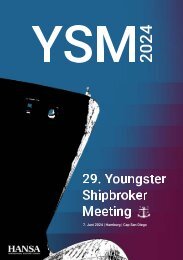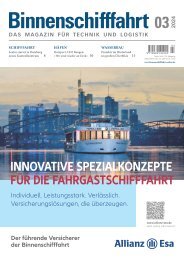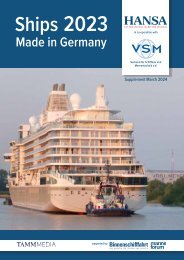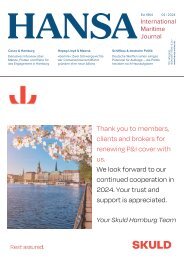HANSA 04-2018
Aktien & Börsen | Marktkompass Offshore | Wasserbau & Planungsrecht | Datenbrillen im Schiffbau | COMPIT 2018 | Fährschifffahrt | Arktische Schifffahrt | Hafnia
Aktien & Börsen | Marktkompass Offshore | Wasserbau & Planungsrecht | Datenbrillen im Schiffbau | COMPIT 2018 | Fährschifffahrt | Arktische Schifffahrt | Hafnia
Erfolgreiche ePaper selbst erstellen
Machen Sie aus Ihren PDF Publikationen ein blätterbares Flipbook mit unserer einzigartigen Google optimierten e-Paper Software.
Schiffstechnik | Ship Technology<br />
»It wouldn’t make sense<br />
to add another box to the ship<br />
that requires constant attention«<br />
Another vital element is the relationship<br />
between ship and shore, which digitalisation<br />
is transforming. Traditionally,<br />
captains have been the ultimate arbiters<br />
of all the information that flows on and<br />
off the ship. So, there are often some cultural<br />
hurdles that need to be overcome<br />
when you’re using<br />
technology that<br />
takes a lot of this<br />
out of their hands.<br />
For instance, captains<br />
might think<br />
that they are being<br />
monitored by a shorebased team that<br />
won’t necessarily understand why certain<br />
decisions were made. Providing a shared<br />
data platform, accessible and populated<br />
by the teams both afloat and ashore, will<br />
build trust.<br />
Coming from a seafaring heritage, we<br />
can see that transparency needs to benefit<br />
both sides. There are two parts to this<br />
– technical and cultural. From the technical<br />
side, we need to make sure that the<br />
reporting environment does not add<br />
work to the workload of those afloat. Instead<br />
we work with legacy systems and<br />
new connectivity services both old and<br />
new, to reduce the time spent on reporting,<br />
while increasing the usefulness of<br />
the data. This could mean, for example,<br />
looking at something like the noon report,<br />
which has for centuries been the<br />
main form that the »narrative« of a voyage<br />
takes. It wouldn’t make sense to add<br />
another box in the ship that requires constant<br />
attention. Instead, if we can find<br />
a way to, at the touch of a button, log<br />
changes in activity, the rest of the data<br />
is supplied by the automatic data collection<br />
of speed, fuel use, etc. This then creates<br />
a chronological picture of the voyage,<br />
which is much more useful and addresses<br />
legislative vessel performance requirements<br />
such as MRV and SEEMP.<br />
With these kinds of technological innovations<br />
in place, on the cultural side,<br />
we can work with our customers to make<br />
sure that the increased level of transparency<br />
they experience ends up as a net<br />
positive for their business. If there’s increased<br />
ship-to-shore transparency, there<br />
needs to be a mutual understanding there<br />
that this is going to be used to enhance<br />
performance – not as a tool to catch the<br />
captain out.<br />
Behaviour is also crucial to maintaining<br />
safety. While collecting more data<br />
doesn’t risk the loss<br />
of control over a<br />
vessel, if data is intercepted<br />
or hacked,<br />
it would have serious<br />
commercial<br />
consequences. Cyber<br />
security needs a joined-up approach<br />
throughout the entire chain of communication.<br />
It needs everyone, at every risk<br />
point, to make sure that they have the appropriate<br />
technology, and more importantly,<br />
human behaviours in place, to<br />
minimize the risk of a security breach.<br />
This is a matter of everyone maintaining<br />
procedures like regularly changing passwords<br />
and not plugging in external devices<br />
without proper precautions. While we<br />
use sophisticated encryption at our end<br />
to maintain data security, and ensure that<br />
the proper policies are in place to prevent<br />
a breach, human behaviour is the determining<br />
factor in keeping data safe.<br />
The most important<br />
key to digital<br />
»Adopting digitalisation<br />
to optimize your business<br />
is a lot like going on a diet«<br />
success however,<br />
is to listen first to<br />
what the shipping<br />
community needs<br />
and adopt a pragmatic<br />
approach to digitalisation – focusing<br />
first on what makes the biggest impact<br />
and »bang for your buck«. Moving in<br />
this way makes it a lot easier to focus on<br />
what’s going to bring the greatest advantages<br />
to the business, collaborating, and<br />
joining the dots that matter, rather than<br />
trying to optimise everything at once.<br />
This is the thinking that underpins<br />
our voyage monitoring offering OTIS<br />
(Online Tracking and Information System),<br />
which provides weather, security<br />
and navigational data. We service over<br />
11.000 vessels, providing location data –<br />
with many thousands of locations transmitted<br />
every day. Allowing owners, operators<br />
and shore crew to see where their<br />
ship is, and what it’s doing minimizes<br />
the risk from adverse situations such as<br />
weather or piracy. This informs the next<br />
phase in our development journey, which<br />
is to use the data we already have (and<br />
new datasets as they become available) –<br />
and to use machine learning techniques<br />
to build predictive models based on analytics<br />
and data from past voyages.<br />
The most important factor here is to<br />
start with what makes the biggest impact<br />
to the total voyage as a whole and go from<br />
there. As we see it, this is weather, which<br />
is the largest contributor to performance<br />
often by orders of magnitude. By comparing<br />
some actual voyages against recommended<br />
routes, we see the scope of some<br />
of the potential savings just from weather<br />
routing. In one example, avoiding adverse<br />
weather could have used one third of the<br />
fuel when compared to the route taken,<br />
and still arrived on time. Looking at efficiency<br />
in this way, it’s clear why we need<br />
to take weather as our starting point.<br />
Adopting Big Data and digitalisation<br />
to optimize your business is a lot like going<br />
on a diet - it’s a journey to becoming<br />
leaner, healthier and more resilient.<br />
And just like a diet,<br />
you need to focus<br />
on the things that<br />
are going to make a<br />
real difference first<br />
– cutting out the<br />
burger and chips<br />
rather than just switching from regular<br />
to diet coke. And similarly, it needs<br />
to take account of your lifestyle and routine<br />
to avoid becoming a crash diet, or<br />
something that is given up after a few<br />
days. Technology needs to do the same<br />
– by taking a pragmatic approach, looking<br />
for the big ticket items and focusing<br />
on the human element, we can use data<br />
to help the shipping community become<br />
healthier in the long term.<br />
Author: Stuart Nicholls,<br />
CEO, StratumFive<br />
info@stratumfive com<br />
<strong>HANSA</strong> International Maritime Journal – 155. Jahrgang – <strong>2018</strong> – Nr. 4 71


















